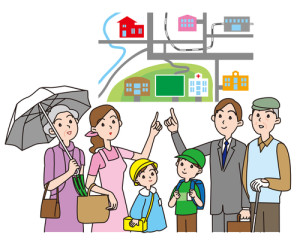 In a new home or neighborhood, preparing for emergencies in advance might just save you or your family member’s life. In Part 2, we cover the basics for inside your house.
In a new home or neighborhood, preparing for emergencies in advance might just save you or your family member’s life. In Part 2, we cover the basics for inside your house.
Know your home:
Learn how to turn off gas, electrical and water lines in the event a disaster damages power lines near your home. Memorize the easiest exits from all rooms in your home. Keep hallways and doorways clear of clutter on a regular basis to avoid family members being trapped, confused, or injured if the power goes out or during an emergency evacuation.
Build A Kit
Create and maintain an emergency kit and keep your kit in an accessible place.
- Water: Keep at least a 3-day supply of water for everyone in your family. This means 1 gallon of water, per person, each day.
Ready.gov advises adding a small amount of household chlorine bleach and a medicine dropper to your kit. “When diluted, nine parts water to one part bleach, bleach can be used as a disinfectant. Or in an emergency, you can use it to treat water by using 16 drops of regular household liquid bleach per gallon of water. Do not use scented, color-safe or bleaches with added cleaners.” - Medicine: Keep a 7+ day supply of any medicine your family needs.
- Food: Keep a supply of non-perishable food that you can make easily.
- Tools: Buy an extra tool set. Add any additional gear you may need specific to your emergency zone. Keep several flashlights, matches, a camera, whistle, dust masks, can opener and a map of the local area. Add to your set plenty of batteries (any type you need for a radio, hearing aids, cordless power supply, flashlights, etc.).
- Clothing and Comfort: Prepare a 3+ day supply of varying types of clothing for each person in your family. Keep and emergency blanket and personal sanitation wipes and towels in the kit.
- Radio: invest in a battery operated or hand-crank radio so you can stay informed.
- Contacts: Buy an emergency cell phone (a pre-paid one works fine), keep it charged, and with your kit—keep a charger in the kit that you do not remove. Put all your emergency contacts in the phone AND in a notebook in the kit.
- Paperwork: If possible, prepare copies of all important documents for you and your family.
- Situation Specific: Remember to adjust the content of this kit for your situation and your family. If you have babies, elderly family members, or pets, if you live in the city or the country, in a single-family home or a multi-unit building the items you need for your kit will vary. Make sure you know what you need.
- Pets: Many shelters cannot accommodate pets. Find pet-friendly shelters in advance and assemble a pet-specific kit to keep your “best friend” safe.
Involve Your Family
Do not wait until emergency strikes to make sure your family knows what to do. You might be prepared, but if the whole family is not on board it can be a struggle to keep everyone safe. Walk your children through the emergency process you design and make sure they have an understandable instruction manual to reference (we suggest images like on airplanes) if you are not home and they need to act. Post the instructions on the fridge, in the bathroom and on the interior of their bedroom door. Make sure they know exactly how to reach you and emergency services.
Prepare well in advance for important documents or treasured photos. An option is to store images of them on a cloud server accessible from any computer. That way, you are not tempted to waste time searching for them when you need to leave your home.
Compliments of Virtual Results


Leave a Reply